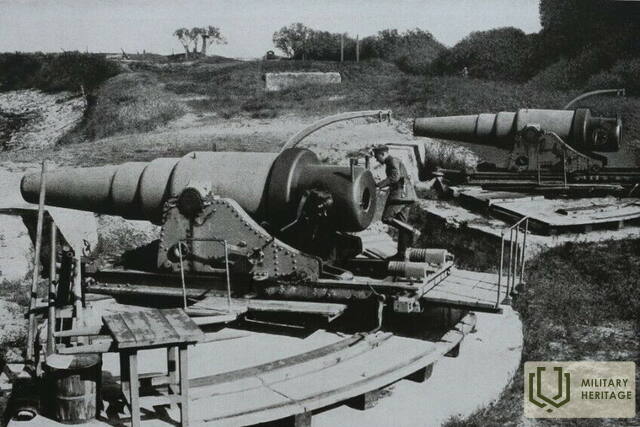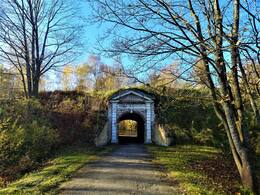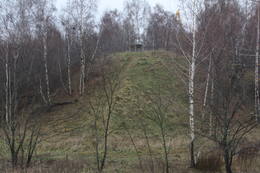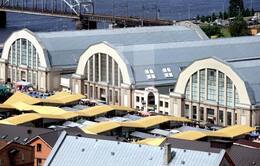About Daugavgriva fortress
The narrator describes an event in the Daugavgrīva fortress during World War I, when it was bombed by an air force in the German army. The fortress was one of the strategic objects that remained important until the end of World War II.
“(..) 1916. In the spring of the night from the third day of Easter to the fourth, the German "Zeppelin" had constantly flown over the detained area of Riga and arrived unexpectedly over the fortress. The guard at the Hapaka River bridge had seen him at the very last moment. The old soldier of the Vologda družina, holding the same "bad" and for fear and anxiety forgot to announce to the chief of the guard and time to raise an alarm, but recovered only when the first bombs, presumably sent to the bridge, began to burst a hundred, fifty steps away from the post. In the material fields of Baloža and P. Bērziņš tree factories, shattering and destroying some sons of sons and blankets. It was a bright moonlight. Light fog low over the bay of the Daugava and the surrounding meadows. The clock was already over at midnight, when the first bomb blasts alarmed the fortress and the surrounding area. A few minutes later, the fortress's radiators began to work, and the bombings were accompanied by the sound of cannon shots and shattering shrapnel, exacerbated by the general silence of the night and the echo in the ramparts of the fortress. After ten or fifteen minutes, everything calmed down, only the batteries of Ķemeri district could still be heard working, presumably accompanied by the flying "Zeppelin". On the second morning, a closer look at the battle area and the damage showed that the latter was negligible. In addition to the already mentioned torn and shattered boards of boards and blankets, the railway dam in the port dam was destroyed, the port dam itself was damaged and that was all, but two unexploded "Zeppelin" bombs had fallen to the ground and remained there. The bombs had to be taken out of the ground and destroyed, because if they were left to their fate, they could explode at any moment and cause great damage and misfortune, especially to those who lay in Bolderaja. (..) ”
The story of memories is published in the newspaper "Latvian Rifleman", no. 4. 1925. The title of the story of memories is “This and this from the life of riflemen in Daugavgrīva”
Related timeline
Related topics
Related objects
Daugavgrīva Fortress
Daugavgrīva Fortress (entry from Birzes street) is located on the Daugavgrīva Island where Buļļupe river joins the Daugava river. The fortress was built in the 17th century to defend from enemies moving in the direction of Riga, which was an important administrative, trade and production centre. Later it became the main fortification of the Latvian Army coastal defence with several support points. This defensive fortification system is one of the most valuable objects of Latvia's military heritage. This fortress has witnessed Latvian military history. For example, during the Crimean War (1853-1856) Latvian and Estonian gunboat crews were trained here. The main objective of these units was to protect local ports and the coast from attacks by the British navy. During World War I Daugavgrīva militiamen companies were formed here. These were the first Latvian combat units, which came even before the Latvian Riflemen. Nowadays it is possible to see the territory of the fortress. ‘Komētforts’ and the Seaside Nature Park are located nearby and Mangaļsala fortifications are on the other side of the Daugava river.
Zeppelin hangars of Riga Central market
Located in the center of Riga, opposite the Riga International Bus Station, near the Riga Railway Passenger Station.
Riga Central Market is the largest market in Latvia, which was once recognized as the best and most modern market in Europe. Its bright symbol is the 20th century. Market pavilions built in the 1920s and originally used for military purposes.
During World War I, the German army established Vaiņode Airport in Kurzeme, where several airships were permanently located. These were elongated-shaped balloons filled with gas and enclosed to carry passengers and cargo. Control was provided by an internal combustion or electric motor and a wing in the housing. The airships were intended for reconnaissance or for bombing an enemy, for example, by attacking a Russian army seaplane airfield on the island of Roņi. The hangars are known to be called Walhalla and Walther.
After the Latvian War of Independence, the hangars were dismantled and used to build the hangars of the Riga Central Market, planning to leave them in their original size. It was later decided to use only the upper parts of the hangars.
Today you can see the metal structures of the German army airship hangar. The market provides a pleasant way to learn about the origins of world aviation. Tour application: +37167358157; gints.aksiks@rct.lv.








